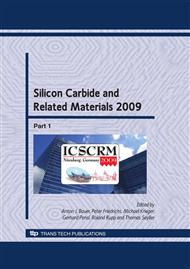p.473
p.479
p.483
p.487
p.491
p.495
p.499
p.503
p.507
Nitridation of the SiO2/SiC Interface by N+ Implantation: Hall versus Field Effect Mobility in n-Channel Planar 4H-SiC MOSFETs
Abstract:
In this paper the electrical and structural characteristics of n-MOSFETs fabricated on 4H SiC with a process based on nitrogen (N) implantation in the channel region before the growth of the gate oxide are reported for low (5x1018 cm-3) and high (6x1019 cm-3) N concentration at the SiO2/SiC interface. The electron mobility and the free carrier concentration in the MOSFET channel were evaluated by Hall effect measurement. The MOSFETs with the higher N concentration had the best electrical characteristics in terms of threshold voltage and field effect mobility, in spite of a lowering of the electron mobility in the channel. The latter is a negative drawback of the fabrication process that probably can be ascribed to an incomplete recovery of the implantation damage or to a high density of interstitial N atoms present in the channel region. In fact, the MOSFETs with the superior electrical performances were fabricated with the higher N+ dose and the shorter thermal oxidation time. However, no evidence of extended defects, clusters or nano-particles in SiC at the interface with the gate oxide was found in every SiC MOSFETs devices observed by electron transmission microscopy
Info:
Periodical:
Pages:
491-494
Citation:
Online since:
April 2010
Keywords:
Price:
Сopyright:
© 2010 Trans Tech Publications Ltd. All Rights Reserved
Share:
Citation:


